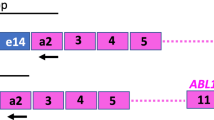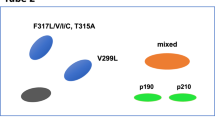Abstract
We sought to establish a rapid and reliable RT-PCR approach for detection and quantification of BCR-ABL fusion transcripts using the LightCycler technology. This device combines rapid thermocycling with online detection of PCR product formation and is based on the fluorescence resonance energy transfer (FRET) between two adjacent hybridization probes carrying donor and acceptor fluorophores. A pair of probes was designed that was complementary to ABL exon 3, thus enabling detection of all known BCR-ABL variants and also normal ABL as an internal control. Conditions were established to amplify less than 10 target molecules/reaction and to detect one CML cell in 105cells from healthy donors. To determine the utility of the assay, we quantified BCR-ABL and ABL transcripts in 254 samples (222 peripheral blood, 32 bone marrow) from 120 patients with CML after therapy with IFN-α (n = 219), allogeneic BMT (n = 17), chemotherapy (n = 11), or at diagnosis (n = 7). The level of residual disease in the 245 BCR-ABL positive specimens was expressed as the ratio of BCR-ABL/ABL. This ratio was compared to results obtained by three established methods from contemporaneous specimens. A highly significant correlation was seen between the BCR-ABL/ABL ratios determined by the LightCycler and (1) the BCR-ABL/ABL ratios obtained by nested competitive RT-PCR (n = 201, r = 0.90, P < 0.0001); (2) the proportion of philadelphia chromosome positive metaphases determined by cytogenetics (n = 81, P < 0.0001); and (3) the bcr ratio determined by southern blot analysis (n = 122, P < 0.0001). we conclude that real-time pcr with hybridization probes is a reliable and sensitive method to monitor cml patients after therapy. the major advantages of the methodology are (1) amplification and product analysis are performed in the same reaction vessel, avoiding the risk of contamination; (2) the results are standardized by the quantification of housekeeping genes; and (3) the complete pcr analysis takes less than 60 min.
This is a preview of subscription content, access via your institution
Access options
Subscribe to this journal
Receive 12 print issues and online access
$259.00 per year
only $21.58 per issue
Buy this article
- Purchase on Springer Link
- Instant access to full article PDF
Prices may be subject to local taxes which are calculated during checkout
Similar content being viewed by others
Author information
Authors and Affiliations
Rights and permissions
About this article
Cite this article
Emig, M., Saußele, S., Wittor, H. et al. Accurate and rapid analysis of residual disease in patients with CML using specific fluorescent hybridization probes for real time quantitative RT-PCR. Leukemia 13, 1825–1832 (1999). https://doi.org/10.1038/sj.leu.2401566
Received:
Accepted:
Published:
Issue Date:
DOI: https://doi.org/10.1038/sj.leu.2401566
Keywords
This article is cited by
-
ASXL1 mutations predict inferior molecular response to nilotinib treatment in chronic myeloid leukemia
Leukemia (2022)
-
Separase activity distribution can be a marker of major molecular response and proliferation of CD34+ cells in TKI-treated chronic myeloid leukemia patients
Annals of Hematology (2020)
-
Impact of unbalanced minor route versus major route karyotypes at diagnosis on prognosis of CML
Annals of Hematology (2015)
-
Molecular-defined clonal evolution in patients with chronic myeloid leukemia independent of the BCR-ABL status
Leukemia (2014)
-
The current status of minimal residual disease assessment in myeloma
Leukemia (2014)



